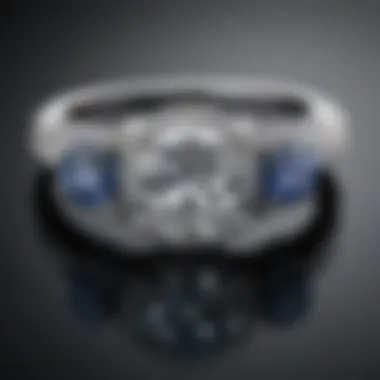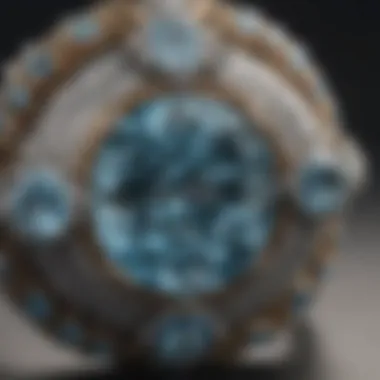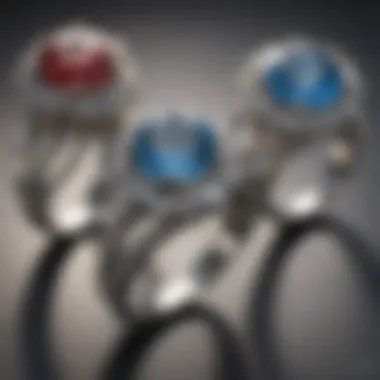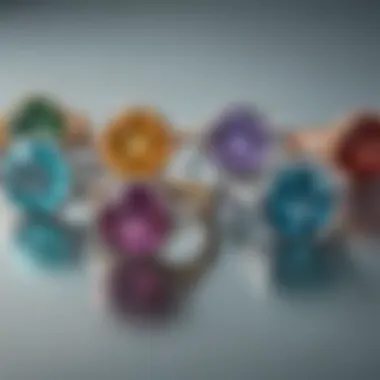Exploring Tiffany's Iconic Three Stone Engagement Rings


Intro
The Tiffany three stone engagement ring represents more than just a piece of jewelry. It embodies a rich tapestry of meaning, history, and art. This style, featuring three prominent gemstones, typically symbolizes the past, present, and future of a relationship. Tiffany's mastery in crafting these rings has not only elevated their status among enthusiasts but also positioned them as aspirational pieces in the luxury jewelry market. In this article, we will delve into the intricacies of the Tiffany three stone engagement ring, focusing on the elements that make it significant.
Gemstone Overview
Understanding the gemstones used in the Tiffany three stone engagement ring is vital for appreciating its beauty and craftsmanship.
Definition and Characteristics
The gemstones in these rings serve as the centerpieces, each selected for its unique attributes. Diamonds, sapphires, and emeralds often feature prominently, given their brilliance and hardness. Diamonds, the most common choice for engagement rings, have an unmatched refractive quality, contributing to their exceptional sparkle. Sapphires and emeralds, with their rich hues, offer a striking contrast that can personalize the ring’s appearance.
Classification of Gemstones
Gemstones can be classified based on their mineral composition and formation. For instance, diamonds are classified as carbon-based minerals, while sapphires belong to the corundum family. Understanding these classifications allows buyers to make informed decisions. Here are some classifications:
- Precious Stones: Diamonds, sapphires, rubies, and emeralds.
- Semi-Precious Stones: Amethyst, citrine, garnet, and tanzanite.
It’s essential to consider the provenance and quality of gemstones. Tiffany’s commitment to ethical sourcing and high standards enhances their appeal among consumers.
"Choosing a gemstone is not just about appearance; it reflects values and personal sentiments as well."
Historical Significance
The history of gemstones is as intricate as their beauty. Understanding their cultural importance provides context to their use in engagement rings.
Ancient Uses and Cultural Importance
Historically, gemstones have been used in various cultures for their perceived mystical properties. In ancient Egypt, emeralds symbolized fertility and rebirth. Meanwhile, sapphires were cherished for their protective powers. These historical uses often influence modern perceptions of gemstones, enhancing their desirability.
Myths and Legends Surrounding Gemstones
Throughout history, myths have surrounded many stones. For example, diamonds were believed to bring invincibility to warriors in battle. Such stories enrich the narrative of the Tiffany three stone engagement ring, creating a deeper connection for the wearer.
By understanding the historical background and cultural significance of gemstones, consumers can gain a better appreciation of the Tiffany three stone engagement ring’s heritage and enduring allure.
Preamble to Tiffany Engagement Rings
Tiffany & Co. has long been synonymous with luxury and excellence in the world of fine jewelry. The engagement ring, as a symbol of commitment and love, is particularly significant in their offerings. The Tiffany three stone engagement ring stands out for its unique design and rich history. This article will explore its importance, craftsmanship, and symbolism, providing insight into what makes Tiffany engagement rings a worthwhile consideration for couples.
The three stone design is more than just aesthetically pleasing; it embodies a narrative of past, present, and future. Each stone represents a distinct chapter in a relationship, making this design profoundly meaningful. As we delve into this topic, we will highlight the intricacies of the Tiffany three stone ring, touching on its legacy, design elements, and practical considerations for potential buyers. By understanding these important facets, readers can better appreciate the enduring appeal of these elegant pieces.
The Legacy of Tiffany & Co.
Tiffany & Co. was founded in 1837 by Charles Lewis Tiffany and John B. Young in New York City. The brand quickly established itself as a premier source for high-quality gemstones and exquisite craftsmanship. Tiffany revolutionized the engagement ring market by introducing the concept of the modern diamond solitaire. This paved the way for the three stone design, which brings a modern twist to classic traditions.
Over the decades, the brand has maintained a reputation for innovation and artistry. Tiffany's commitment to ethical sourcing of gemstones further enhances its prestige. Each piece reflects a meticulous attention to detail, with an emphasis on high-quality materials. This legacy has made Tiffany rings a coveted choice for engagement.
Understanding the Three Stone Design
The three stone engagement ring comprises a central stone flanked by two smaller stones on either side. This design serves a dual purpose: it enhances the ring's overall beauty while carrying significant symbolic weight. The central stone often represents the love shared between partners, while the side stones signify friendship and fidelity.
When it comes to gemstone options, diamonds remain the most popular choice, but alternative gemstones like sapphires, emeralds, or rubies can also add a personalized touch. The three stone design allows couples to customize their rings in myriad ways. This flexibility makes it an appealing choice for those wanting a unique piece that reflects their individual stories.
The design resonates with many consumers today, highlighting the emotional connection behind such purchases. Couples selecting a Tiffany three stone engagement ring are not just choosing a piece of jewelry; they are investing in a legacy—one that intertwines artistry and emotion into a timeless symbol of love.
"Every Tiffany engagement ring tells a story, and with the three stone design, that story unfolds beautifully through its symbolism and exquisite craftsmanship."


As we continue discussing Tiffany's three stone engagement rings, we will dive deeper into their historical background, design elements, and what aspiring buyers should consider before making their choice.
Historical Background of Three Stone Rings
The history of three stone engagement rings is rich and multifaceted. Their significance extends beyond mere aesthetics, embodying narratives of love, commitment, and tradition. Over time, the three stone design has captured the imagination of both couples and jewelers alike. Understanding this background not only enhances appreciation of the rings but also informs potential buyers about their investment.
Origins of the Three Stone Concept
The concept of the three stone ring can be traced back to medieval Europe. Initially, these rings symbolized the past, present, and future of a relationship. The three stones represented distinct phases of love, emphasizing a continuous journey together.
In various cultures, the number three holds deep meaning. In Christianity, for example, it is often associated with the Holy Trinity, adding a spiritual dimension to relationships. As these rings became more popular, they evolved into a beloved engagement choice, preferred by many for their deep symbolism.
Furthermore, in the late 20th century, the three stone style gained significant traction due to iconic celebrity endorsements. These prominent figures highlighted the elegance and narrative depth of the design, making it a sought-after choice for engagements.
Evolution of Styles Over Time
As fashion and jewelry design evolved, so did the aesthetics of three stone rings. The Victorian era saw intricate metalwork and elaborate settings, often reflecting the art and crafts movement. This period introduced innovative styles that continued to influence modern designs.
In the 20th century, the rise of platinum and diamond prominence marked a significant shift. Tiffany & Co. played a pivotal role in this transformation, perfecting the balance of craftsmanship and design. Their commitment to quality established a standard that many other jewelers aspired to.
In contemporary markets, various styles have emerged, including vintage, modern, and even alternative gemstones. The choice of center stone, accent stones, and settings has diversified greatly, allowing couples to personalize their rings according to their unique narratives.
"Three stone engagement rings represent a journey through love, capturing moments across time."
The evolution continues today, with shifts in consumer preference towards bespoke designs or ethically sourced materials. This flexibility allows buyers to reflect individual tastes while still honoring the traditional meanings behind these exquisite rings.
The historical journey of three stone engagement rings enriches their significance, making them much more than a simple adornment. A rich narrative surrounds each piece, captivating those involved in the jewelry and gemstone industry.
Design Elements of Tiffany Three Stone Rings
The design of Tiffany’s three stone engagement rings reflects a harmony of elegance and meaning. Each element is crucial as it serves to enhance the visual appeal while embodying a deeper significance. Understanding these design elements can help potential buyers appreciate the craftsmanship and intentionality behind every ring.
Choosing the Center Stone
Choosing the center stone is perhaps the most significant decision in creating a three stone engagement ring. This choice sets the tone for the entire piece. It is essential to consider the qualities of the stone carefully.
Diamond Selection
When selecting a diamond, clarity is paramount. Diamonds are valued for their brilliance and clarity, which directly affects their beauty. A well-chosen diamond acts as a focal point in the ring. Diamonds, with their unique sparkle, serve as a traditional favorite, often associated with commitment and everlasting love. One unique feature of diamonds is their ability to refract light, creating an exceptional display of color and brilliance. However, diamonds can be expensive, making them less accessible to some buyers.
Alternative Gemstones
Alternative gemstones present an attractive option for those seeking something distinct. Gemstones such as sapphires, emeralds, or rubies confer unique colors and personal significance. A key characteristic of these stones is their variety and the personal touch they can bring to the ring. Opting for an alternative can showcase individuality. However, some may argue that they lack the enduring value that diamonds represent. This consideration is important for those thinking about long-term investment.
Accent Stones and Their Significance
Accent stones complete the overall design and add depth and character to the ring. They are not merely decorative; they carry meaning and contribute to the narrative behind the ring.
Size and Shape Considerations
The size and shape of accent stones are key to their visual impact. Choosing the right size can significantly affect the balance of the ring. Larger stones can draw attention, while smaller stones can enhance and complement the center stone. The shape, whether it be oval, pear, or princess, influences not only aesthetics but also how the stones interact with light. Each combination presents its own advantages, like a more unique appearance versus a more classic look.
Color and Clarity
Color and clarity of the accent stones also play a vital role. A well-matched color with the center stone enhances the coherence of the design. Clear accent stones allow light to reflect beautifully, enhancing the overall brilliance of the ring. It is important to find a harmony in color that resonates with the personal style of the wearer. However, less clarity may affect how light interacts with the stones, which is something to bear in mind.
Settings and Metal Choices


The setting of the engagement ring and the metal choice holds significance in both style and durability. The setting influences how the stones are displayed and how secure they are.
Platinum vs. Gold
Platinum is often seen as a premium choice due to its durability and hypoallergenic properties. It offers a contemporary feel that many couples appreciate. Gold, on the other hand, is a classic choice with a warm hue that appeals to traditional sensibilities. Each metal has its unique features. Platinum is heavier but resistant to tarnish, while gold provides varied colors, such as white, yellow, or rose. Buyers should consider their lifestyle and preferences when choosing between these metals.
Unique Settings
Unique settings can enhance the individuality of a Tiffany ring. Settings such as pave, bezel, or tension can transform a traditional design into something bespoke. A notable benefit is the opportunity to express personal style. However, unique settings might complicate resizing or repairs in the future, which is something to ask about before purchase.
In summary, each design element plays a significant role in defining the identity and message of Tiffany's three stone engagement rings. From selecting the right stones to choosing the metal and setting, every aspect deserves careful consideration.
Symbolism of the Three Stone Engagement Ring
The Tiffany three stone engagement ring is not merely a piece of jewelry; it represents deep meaning and significant symbolism. Each of the three stones typically symbolizes different aspects of a relationship: the past, the present, and the future. This encapsulation of time resonates with couples, offering them a tangible connection to their journey together.
Many buyers regard the three stone ring as a powerful statement about what the relationship embodies. Unlike single-stone rings, which may hold a more traditional view of engagement, the three stones provide a narrative arc that speaks to evolving love. The presence of the three stones highlights not only a commitment but also friendship and a fidelity that grows with time.
Love, Friendship, and Fidelity
The symbolism in a Tiffany three stone engagement ring is intricately tied to love, friendship, and fidelity. Each component of the design offers a distinct message about the commitment shared between partners. The first stone signifies the love that brought them together, a representation of the initial spark and connection. The second stone denotes the present moment, a celebration of their companionship and the life they are building together. The third stone looks to the future, embodying hopes, dreams, and promises yet to come.
It is this Trinity that many couples find profoundly appealing. The design resonates with their understanding of relationships: that love is cultivated through friendship and is sustained by loyalty. This layered meaning fosters a sense of security and reassurance.
"The three stone engagement ring is a constant reminder of what has been, what is, and what could be."
Cultural Interpretations
Different cultures interpret the symbolism of the three stone engagement ring in various ways. In Western societies, the trinity of stones is often taken to represent the holy trinity of love, but variations exist across the globe. Some cultures associate the three stones with harmony and balance within a relationship.
In certain Eastern cultures, the trilogy signifies the union of earth, water, and fire, elements that are crucial for a harmonious life together. Such interpretations enrich the ring's meaning, allowing individuals from diverse backgrounds to connect with the design.
Ultimately, the three stone engagement ring, particularly one from Tiffany, serves as a profound emblem of love’s journey, reflecting deeper sentiments and cultural significances that vary among individuals. This awareness adds an extra layer when one chooses a ring, making it not just a purchase, but a significant milestone.
The Craftsmanship Behind Tiffany Rings
The craftsmanship behind Tiffany rings represents a fusion of artistry, precision, and time-honored techniques. Each engagement ring is not merely a piece of jewelry but a testament to the skill and dedication of artisans who create them. This section will explore the essential elements that contribute to the intricacy and overall beauty of the Tiffany three stone engagement ring. By understanding craftsmanship, one can appreciate the true value and significance of these exquisite pieces.
The Art of Gem Cutting
Gem cutting is a crucial aspect of ring design that defines not only the aesthetic value but also the optical performance of the gemstones. The cut refers to how a gemstone is shaped and polished, with various styles available, such as brilliant, princess, or cushion cuts. Each cut style showcases the gem's characteristics in unique ways.
For example:
- Brilliant cut maximizes sparkle through skillful faceting.
- Princess cut retains more rough material while offering a modern look.
- Cushion cut combines a vintage feel with a unique glow.
Every Tiffany ring is meticulously crafted to ensure that the center and accent stones reflect light beautifully. A well-cut stone not only enhances visual appeal but also can increase its value. Therefore, understanding the nuances of gem cutting is vital for anyone looking to invest in luxury pieces.
Expert Artisan Techniques
Tiffany places an emphasis on traditional techniques passed down through generations. The artisans at Tiffany & Co. are highly trained and often specialize in specific skills. Each technique serves a unique purpose in the creation of a ring.
Some key techniques include:
- Hand engraving: Provides a personal touch, making each piece unique.
- Micro-pavé setting: Allows for a seamless look by setting smaller stones closely together, increasing sparkle.
- Channel setting: Offers security for each stone while creating a modern, streamlined appearance.
The meticulous attention to detail in these methods ensures that each Tiffany ring not only meets high-quality expectations but also maintains the brand's legacy of excellence. The artisans interpret design concepts into tangible art, ultimately contributing to the ring's story and value.


The combination of advanced technology and traditional skill sets Tiffany apart in the crowded jewelry market.
Practical Considerations for Consumers
When it comes to purchasing a Tiffany three stone engagement ring, understanding the practical considerations can significantly influence your decision. This section lays out vital elements that every consumer should keep in mind. Making an informed choice can enhance the overall experience, creating lasting satisfaction with your purchase.
Evaluating Quality and Value
The evaluation of quality and value in Tiffany rings requires a discerning eye. Generally, the hallmark of Tiffany & Co. is its commitment to superior craftsmanship. Not only do customers receive a stunning piece of jewelry, but they also invest in a product that carries a reputation for excellence.
When examining the individual stones, pay attention to the four Cs: cut, color, clarity, and carat weight. These factors dominate the jewelry conversation, particularly when selecting diamonds. Different combinations of these elements can dictate a stone’s price and desirability. It is also crucial to consider the overall setting and how the trio of stones frames the center gem.
Furthermore, Tiffany & Co. offers comprehensive certifications and detailed information about each gem. This ensures that buyers acquire a ring reflecting true value rather than merely the perceived market trends. In short, investing time to evaluate quality can elevate your understanding of the piece's worth.
Choosing the Right Ring Size
Selecting the correct ring size is essential for comfort and style. A poorly sized ring can lead to discomfort and even loss. Unlike standard rings, the Tiffany three stone engagement rings have intricate designs that can be more noticeable when the fit isn’t right. Consequently, getting the size correct should be a priority.
There are a few methods to determine the proper size. One is to visit a jeweler for precise measurements. Alternatively, one can measure an existing ring that fits well. Online resources and conversion charts can offer further guidance, allowing for a comparison of sizes, even if they differ in location.
Understanding how the ring sits on the finger not only affects aesthetics but also the daily wearability of the jewelry piece.
Insurance and Aftercare
Once a Tiffany three stone engagement ring is purchased, it becomes essential to consider its protection and ongoing care. Insuring the ring against loss or damage is a prudent step. Most jewelry insurers offer tailored policies that cover gemstones. This allows owners to have peace of mind when wearing or storing their valuable item.
Having an insurance policy also facilitates a streamlined replacement process in case of theft or damage. Make sure to keep detailed receipts and certification documents, as they will be needed for claims.
Aftercare is equally important. Regular cleaning and maintenance keep the ring in pristine condition. Tiffany & Co. often provides cleaning solutions and suggestions for proper care. Alternatively, visiting a jeweler for professional cleaning and checking can enhance the longevity of the ring. This is an often-overlooked aspect that can make a significant difference in the appearance and durability of the piece.
“Owning a Tiffany three stone engagement ring is more than just having a beautiful piece of jewelry; it is an investment in quality and legacy.”
Market Trends in Three Stone Engagement Rings
The market for three stone engagement rings is dynamic and reflects broader cultural shifts and consumer preferences. A deep understanding of these trends can aid potential buyers and collectors in making informed decisions. Tiffany's three stone rings, in particular, occupy a prestigious place in this market, as they symbolize timelessness combined with modern sensibilities. These rings not only represent commitment, but they also serve as an investment, tapping into both emotional and financial dimensions.
Current Consumer Preferences
Consumer preferences play a crucial role in shaping the trends in three stone engagement rings. Today’s buyers are increasingly informed and seek uniqueness in their selection. They prefer rings that tell a story or hold personal significance. Some specific preferences include:
- Customization: Many customers desire personalized designs, choosing unique gemstone combinations or custom settings. Tiffany's offerings allow for significant flexibility while maintaining high standards of quality.
- Ethical Sourcing: Buyers today are more conscious of the origins of their gemstones. Ethical sourcing has become a significant factor in purchase decisions. Tiffany & Co. has continuously upheld this standard, reassuring customers regarding their commitment to ethical practices.
- Versatile Styles: Functionality is key for modern buyers. They aim for rings that can transition from formal events to casual outings. Three stone rings from Tiffany blend classic and contemporary styles, catering to this need.
The importance of these preferences appears not only in consumer satisfaction but also in improved brand loyalty. Tiffany recognizes this, consistently adapting to meet the evolving needs of its clientele.
Investment Potential of Tiffany Rings
Investing in Tiffany three stone engagement rings can provide both emotional rewards and financial benefits. The market for fine jewelry remains robust, and such pieces tend to appreciate over time. Some considerations regarding investment potential include:
- Brand Legacy: Tiffany's reputation for luxury and quality is unmatched. Their rings often retain or increase in value due to brand recognition.
- Quality of Materials: Gems selected for Tiffany pieces are expertly cut and set, making them more valuable than average mass-produced counterparts. Buyers often find that these rings stand the test of time.
- Limited Editions: Specific cuts or collections may be produced in limited quantities. These limited editions can command higher resale prices, making them sound investments for collectors.
As a result, Tiffany's three stone engagement rings are not only symbols of love but also hold potential as significant financial assets.
Investing in a Tiffany ring is not just about purchasing a piece of jewelry; it's about securing a part of a legacy that is synonymous with elegance and prestige.
Epilogue: The Enduring Appeal of Tiffany Three Stone Rings
The Tiffany three stone engagement ring stands as a symbol of eternal love, reflecting a connection that endures through time. This concludes the exploration of a design that marries beauty with profound meaning. The three stones represent past, present, and future, emphasizing a relationship's journey. Each ring encapsulates not just the aesthetic appeal, but also deep emotional resonance, making it a preferred choice among couples.
Understanding the enduring appeal requires examining multiple factors. Craftsmanship is paramount. Tiffany & Co. is renowned for its meticulous attention to detail. The clarity of the stones, the quality of the metals, and the overall artistry contribute to an piece that exudes luxury. Each ring is an investment, representing not only a financial choice but also a heartfelt sentiment.
In today's market, there is a growing trend among consumers seeking unique engagement symbols that convey personal stories. This aligns well with the three stone concept, as couples often choose specific stones that hold significance to their relationship. This personal touch enhances the ring's value and connection.
Moreover, tradition plays a critical role. Tiffany's rich history in fine jewelry imbues each piece with a legacy that attracts discerning buyers. The brand's commitment to quality ensures that these rings remain timeless. This classic nature resonates with both traditionalists and modern couples alike.
"A Tiffany ring is not merely a piece of jewelry; it’s an heirloom to be cherished for generations."







